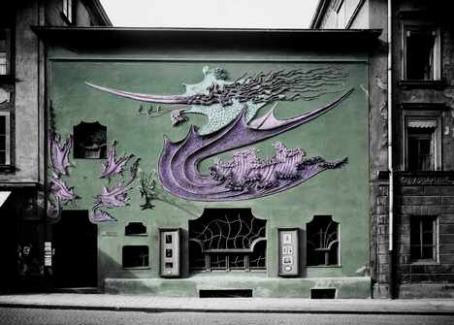
Atelier Elvira (1897-98).
Seeing as there’s been a run of Art Nouveau-related posts here it’s worth mentioning a location that’s familiar to students of the Jugendstil but less well-known to the world at large. August Endell’s Atelier Elvira was a Munich studio building whose exterior decoration of a very stylised dragon creature manages to be even more exaggerated than similar work by Antoni Gaudí. Munich was the centre of German arts and crafts and produced much home-grown Art Nouveau but this eruption of bizarre plasterwork in an otherwise mundane street was still surprising. The façade was painted green, as in the tinted photo above, and the dragon painted different colours each year, yellow, red and so on.
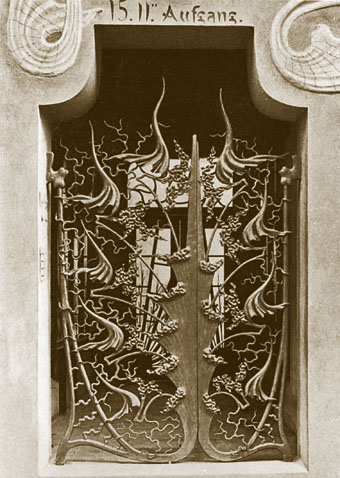
The ironwork street entrance.
Needless to say, not everyone looked upon this kind of challenging décor favourably. In 1937 the Nazi Oberbürgermeister complained about the “hideous façade disrupting the character of the rest of the street” and had the dragon design chipped off the wall. Allied bombs did for the rest a few years later so these pictures are all that we have left.
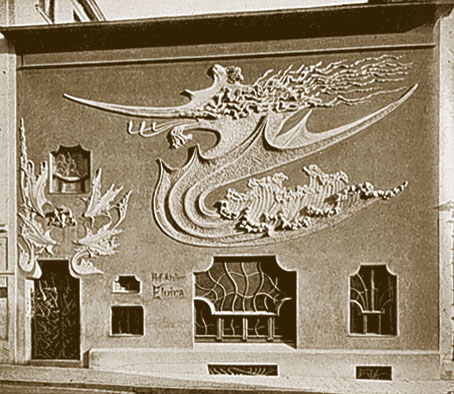
More exterior views.
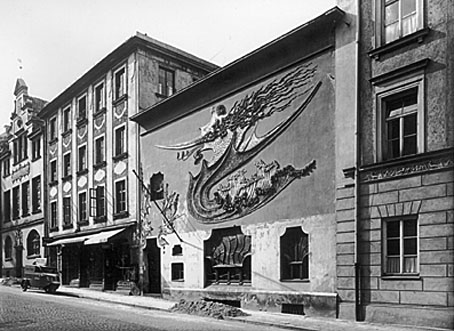
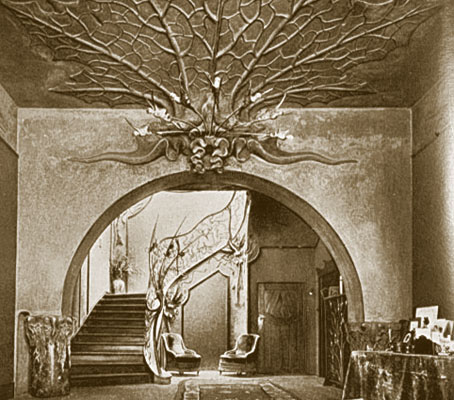
The interior.
Previously on { feuilleton }
• Louis Bonnier’s exposition dreams
• The Maison Lavirotte
• The House with Chimaeras

Wow. What a fabulous club that would be!
Yes indeed. I wish there were more photos, there’s all sorts of curious detail inside.
I found an odd fact that was difficult to confirm so I left it out of the post, namely that one Lou Andreas-Salomé, a Russian-German novelist, is mentioned on this page as visiting the Hof Atelier Elvira in Vienna, described as “a gathering place for gay men and lesbians”. Now the place which concerns us here was in Munich, not Vienna, but was also known as the Hof Atelier Elvira. Furthermore, the German Wikipedia page about the Munich building mentions Lou Andreas-Salomé. Maybe it’s the same place? If anyone reading this has more info then please leave a comment.
That article was quite interesting, but you never know when it comes to fact checking. The two places could have been related in some way. or the one in Munich could be the one mentioned. At any rate, what an interesting character!
The same could be said about you, John!
I had seen photos of the facade but never of the inside and this staircase is incredible. I can see that the buidling must have been thought as decadent… Shame though, war damage would have been bad enough (a lot of the lovely Ecole de Nancy buildings in Nancy have disappeared in bombings and we are left with only pictures or ina few cases the achitectural drawings).
Apparently attractive and mundane are synonyms to ones average John and Jane Doe. The building and its decor really do bare resemblance to something straight out of an anime.
Lou Andreas-Salome was photographed at the Atelier Elvira
in MUNICH by Sophia Goudstikker (known as ‘Puck’) in the spring of 1896. The varied poses of Andreas-Salome, then in her 30s,
with a huge fur collar were Goudstikker’s work. Lora Wildenthal describes the studio as a center of “gay and lesbian social life
and intellectual and artistic life in Munich” at the turn of the century. See Lora Wildenthal, German Women for Empire, 1884-1945, Duke University Press, 2001, p.66.
Sophia Goudstikker was my great great aunt. She was my grandfather’s aunt, so I have been looking up everything I can about her and the Atelier Elvira. First of all, one of the commentators says it was a “club”. In German a studio, or atelier, is where photographs are taken, where paintings are painted etc. Not a club. After Anita Auersperg (spelling?) left the studio, Sophia went on to work with her sister, called Mathilde Nora Goudstikker. Both of them had contacts with intellectuals living in Munich. (Mathildas correspondence with Rainer Maria Rilke is even in a literary museum in Germany). Some German books mention the sisters in relation to these authors. They even knew Thomas Mann’s wife when she was a teenager, especially as they lived nearby. Our family called Mathilda, Tante Tilly. She later married a professor at the Technical University. And, yes, Sophia was gay. She died 1924. I have been trying to find relations of Mathilda. The story I read about the fassade of the building was that Hitler himself drove by once and commented on the …. style of the building. What two places are the commentors talking about, I wonder. Anyway, plenty of books and internet sites mention how Sophia and Mathilde Nora Goudstikker frequented intellectual circles. By the way, even though I am related, it took many years till I finally found the exact relationship with Jacques Goudstikker, the dutch art collector. I already had family information that we were related, but recently a dutch website published a family tree. Jacques Goudstikker and Sophia were cousins, both from families in Utrecht and Amsterdam.
Munich could rebuild it.